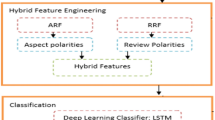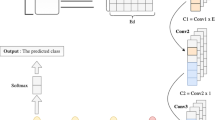Abstract
In recent times, online shopping has become commonly used method for consumers to make purchases and engage in consumption with the rapid advancement of Internet technology. Enhancing user satisfaction is achievable through sentiment analysis (SA) of the enormous user evaluations found on e-commerce platforms. However, accurately predicting the sentiment orientations of these user reviews remains a challenge due to varying sequence lengths, text arrangements, and intricate logic. Nowadays, sentiment analysis is widely employed to assess customer feedback, which holds great significance in determining a product's success. In the past, people relied on word-of-mouth reviews to judge a product's quality. This practice of sentiment analysis is extensively applied in social media. Natural language processing (NLP) plays a crucial role in deciphering sentiment, also referred to as opinion mining or emotion AI, as it encompasses the collective perception of customers. In this manuscript, a Hamiltonian Deep Neural Networks-based Sentiment Analysis on Product Recommendation System (HDNN-SCOA-SA-PR) is proposed. First, the data are gathered from Amazon Product Reviews dataset. Then the data are pre-processed utilizing adaptive self-guided filtering for space tokenization, Gensim lemmatization, and Snowball stemming. By using Structured Optimal Graph-Based Sparse Feature Extraction, the features are extracted. Extracted features are selected using Single Candidate Optimization Algorithm. Finally, the classification process is done using Hamiltonian deep neural network and classified sentiment analysis as positive, negative, neutral. The proposed HDNN-SCOA-SA-PR method is activated in Python, and the efficiency of the proposed method is analyzed with different metrics, such as accuracy, sensitivity, RoC, precision, error rate, F1-score,computation time. ROC is evaluated and compared to the existing methods, such as sentiment analysis based upon machine learning of online product reviews with term weighting including feature selection (SAPR-FS-ENN), sentiment analysis of product reviews depend upon weighted word embeddings along deep neural networks (SAPR-WWE-DNN), improving sentiment analysis for social media applications utilizing an ensemble deep learning language (ISA-SMA-ECN-PR), respectively.







Similar content being viewed by others
Data availability
Data sharing is not applicable to this article as no new data were created or analyzed in this study.
References
CP Shirley J Kumar K Pitambar Rane N Kumar D Radha Rani K Harshitha M Tiwari 2023 IoT device type identification using training deep quantum neural networks optimized with a chimp optimization algorithm for enhancing IoT security J. High Speed Netw. https://doi.org/10.3233/JHS-230028
L Yang Y Li J Wang RS Sherratt 2020 Sentiment analysis for E-commerce product reviews in Chinese based on sentiment lexicon and deep learning IEEE Access 8 23522 23530
BS Rintyarna R Sarno C Fatichah 2020 Enhancing the performance of sentiment analysis task on product reviews by handling both local and global context Int. J. Inf. Decis. Sci. 12 1 75 101
S Zhu Z Yu 2020 Self-guided filter for image denoising IET Image Proc. 14 11 2561 2566
K Dashtipour M Gogate J Li F Jiang B Kong A Hussain 2020 A hybrid Persian sentiment analysis framework integrating dependency grammar based rules and deep neural networks Neurocomputing 380 1 10
B Ray A Garain R Sarkar 2021 An ensemble-based hotel recommender system using sentiment analysis and aspect categorization of hotel reviews Appl. Soft Comput. 98 106935
HJ Alantari IS Currim Y Deng S Singh 2022 An empirical comparison of machine learning methods for text-based sentiment analysis of online consumer reviews Int. J. Res. Mark. 39 1 1 19
W Atteveldt Van MA Velden Van der M Boukes 2021 The validity of sentiment analysis: comparing manual annotation, crowd-coding, dictionary approaches, and machine learning algorithms Commun. Methods Meas. 15 2 121 140
F Xu Z Pan R Xia 2020 E-commerce product review sentiment classification based on a naïve Bayes continuous learning framework Inf. Process. Manage 57 5 102221
S Yi X Liu 2020 Machine learning based customer sentiment analysis for recommending shoppers, shops based on customers’ review Complex Intell. Syst. 6 3 621 634
AD Vo QP Nguyen CY Ock 2020 Semantic and syntactic analysis in learning representation based on a sentiment analysis model Appl. Intell. 50 663 680
B AlBadani R Shi J Dong 2022 A novel machine learning approach for sentiment analysis on twitter incorporating the universal language model fine-tuning and SVM Appl. Syst. Innov. 5 1 13
NM Alharbi NS Alghamdi EH Alkhammash JF Al Amri 2021 Evaluation of sentiment analysis via word embedding and RNN variants for Amazon online reviews Math. Probl. Eng. 2021 1 10
A Ishaq S Asghar SA Gillani 2020 Aspect-based sentiment analysis using a hybridized approach based on CNN and GA IEEE Access 8 135499 135512
ME Basiri S Nemati M Abdar E Cambria UR Acharya 2021 ABCDM: An attention-based bidirectional CNN-RNN deep model for sentiment analysis Futur. Gener. Comput. Syst. 115 279 294
J Liu Y Zhou X Jiang W Zhang 2020 Consumers’ satisfaction factors mining and sentiment analysis of B2C online pharmacy reviews BMC Med. Inform. Decis. Mak. 20 1 13
C Zhang YX Tian ZP Fan Y Liu LW Fan 2020 Product sales forecasting using macroeconomic indicators and online reviews: a method combining prospect theory and sentiment analysis Soft. Comput. 24 6213 6226
H Zhao Z Liu X Yao Q Yang 2021 A machine learning-based sentiment analysis of online product reviews with a novel term weighting and feature selection approach Inf. Process. Manag. 58 5 102656
A Onan 2021 Sentiment analysis on product reviews based on weighted word embeddings and deep neural networks Concurr. Comput. Pract. Exp. 33 23 e5909
A Alsayat 2022 Improving sentiment analysis for social media applications using an ensemble deep learning language model Arab. J. Sci. Eng. 47 2 2499 2511
Z Liu Z Lai W Ou K Zhang R Zheng 2020 Structured optimal graph based sparse feature extraction for semi-supervised learning Signal Process. 170 107456
TM Shami D Grace A Burr PD Mitchell 2022 Single candidate optimizer: a novel optimization algorithm Evol. Intell. https://doi.org/10.1007/s12065-022-00762-7
CL Galimberti L Furieri L Xu G Ferrari-Trecate 2023 Hamiltonian deep neural networks guaranteeing nonvanishing gradients by design IEEE Trans. Autom. Control 68 5 3155 3162
S Hu A Kumar F Al-Turjman S Gupta S Seth 2020 Reviewer credibility and sentiment analysis based user profile modelling for online product recommendation IEEE Access 8 26172 26189
J Zhang A Zhang D Liu Y Bian 2021 Customer preferences extraction for air purifiers based on fine-grained sentiment analysis of online reviews Knowl.-Based Syst. 228 107259
Acknowledgements
Not applicable.
Funding
This research did not receive any specific grant from funding agencies in the public, commercial, or not-for-profit sectors.
Author information
Authors and Affiliations
Contributions
AN (corresponding author) helped in conceptualization, methodology, writing—original draft preparation. PK supervised the study.
Corresponding author
Ethics declarations
Competing interests
The authors declare no competing interests.
Ethical approval and Consent to participate
This article does not contain any studies with human participants performed by any of the authors.
Additional information
Publisher's Note
Springer Nature remains neutral with regard to jurisdictional claims in published maps and institutional affiliations.
Rights and permissions
Springer Nature or its licensor (e.g. a society or other partner) holds exclusive rights to this article under a publishing agreement with the author(s) or other rightsholder(s); author self-archiving of the accepted manuscript version of this article is solely governed by the terms of such publishing agreement and applicable law.
About this article
Cite this article
Ajmeera, N., Kamakshi, P. Hamiltonian deep neural network fostered sentiment analysis approach on product reviews. SIViP 18, 3483–3494 (2024). https://doi.org/10.1007/s11760-024-03014-6
Received:
Revised:
Accepted:
Published:
Issue Date:
DOI: https://doi.org/10.1007/s11760-024-03014-6




